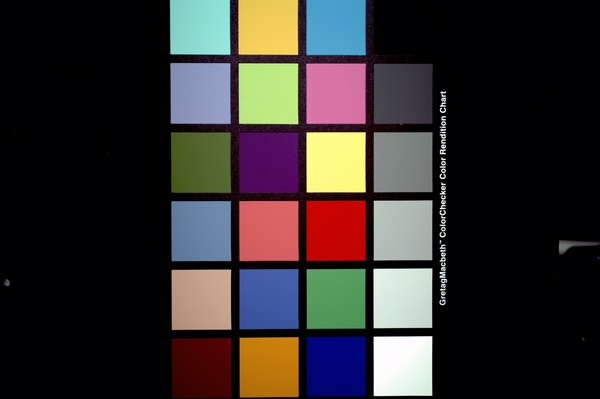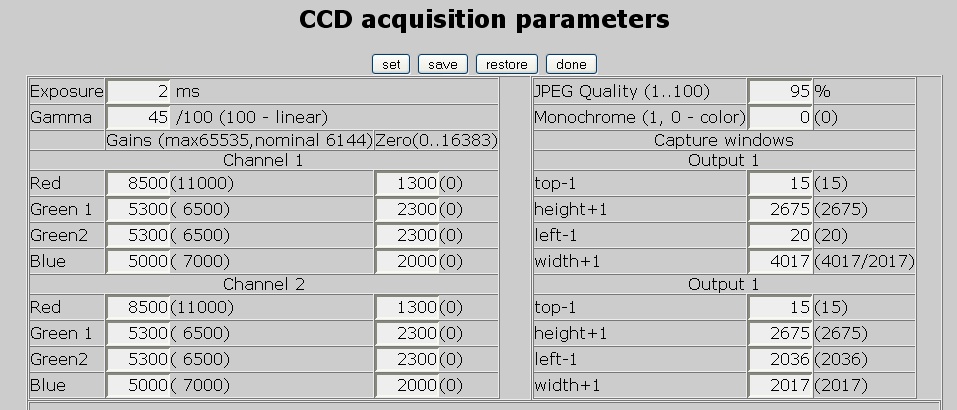Difference between revisions of "Talk:Using the cameras"
(serial baud rate) |
|||
| (One intermediate revision by one other user not shown) | |||
| Line 3: | Line 3: | ||
I photographed a GretagMacbeth Color Rendition Chart with a 323 camera equipped with a Grade 2 color microlens CCD. The lens was a 60mm MicroNikkor, set at wide open aperture. Illumination was from a single Elinchrom 600S set to about 25 watt seconds, equipped with a 14x20" Chimira softbox with both diffusing panels in place. With the target in a vertcal plane and the camera aligned on the center normal, the bottom of the softbox was positioned about 6" above the back of the 323, angled down at the target. The CCD to target distance was about 0.8m. The soft box to target was about 0.95m along the center to center beeline. | I photographed a GretagMacbeth Color Rendition Chart with a 323 camera equipped with a Grade 2 color microlens CCD. The lens was a 60mm MicroNikkor, set at wide open aperture. Illumination was from a single Elinchrom 600S set to about 25 watt seconds, equipped with a 14x20" Chimira softbox with both diffusing panels in place. With the target in a vertcal plane and the camera aligned on the center normal, the bottom of the softbox was positioned about 6" above the back of the 323, angled down at the target. The CCD to target distance was about 0.8m. The soft box to target was about 0.95m along the center to center beeline. | ||
| − | The following image is reasonably numerically (+- 5%) close to the RGB specifications for the target, and subjectively looks very good. | + | The following image is reasonably numerically (+- 5% typical) close to the RGB specifications for the target, and subjectively looks very good. |
[[Image:121705-13.jpg]] | [[Image:121705-13.jpg]] | ||
| Line 15: | Line 15: | ||
This camera uses a test version of software that allows capture to be triggered by pulling CTS1 low on the master compressor. This pin is available on the power supply header connector. The flash is triggered via Pocket Wizard, whose Port 1 input is paralleled to CTS1. Both inputs float at 3.3v. The exposure period must be set long at 2 ms because the Pocket Wizard radio link takes about 1 mS. | This camera uses a test version of software that allows capture to be triggered by pulling CTS1 low on the master compressor. This pin is available on the power supply header connector. The flash is triggered via Pocket Wizard, whose Port 1 input is paralleled to CTS1. Both inputs float at 3.3v. The exposure period must be set long at 2 ms because the Pocket Wizard radio link takes about 1 mS. | ||
| − | From this example, it appears that if you can nail the exposure, you'll get good photos. Until higher resolution raw data becomes available (preferably in [http://www.adobe.com/products/dng/main.html Adobe DNG format], this is a good workaround. | + | From this example, it appears that if you can nail the exposure, you'll get good photos. Until higher resolution raw data becomes available (preferably in [http://www.adobe.com/products/dng/main.html Adobe DNG format]), this is a good workaround. |
| + | |||
| + | == serial baud rate == | ||
| + | |||
| + | using the 10394 board with a 353 camera, the correct baud rate for the serial port seems to be 115200, with version 7.1.0.9 firmware. | ||
Latest revision as of 15:19, 17 October 2007
Using the 323 with Flash Illumination -- Suggested settings
I photographed a GretagMacbeth Color Rendition Chart with a 323 camera equipped with a Grade 2 color microlens CCD. The lens was a 60mm MicroNikkor, set at wide open aperture. Illumination was from a single Elinchrom 600S set to about 25 watt seconds, equipped with a 14x20" Chimira softbox with both diffusing panels in place. With the target in a vertcal plane and the camera aligned on the center normal, the bottom of the softbox was positioned about 6" above the back of the 323, angled down at the target. The CCD to target distance was about 0.8m. The soft box to target was about 0.95m along the center to center beeline.
The following image is reasonably numerically (+- 5% typical) close to the RGB specifications for the target, and subjectively looks very good.

The chart is rotated to avoid the huge horizontal QE falloff of the CCD.
With a Minolta IVF light meter in non-corded mode, the (incident) illumination reads f/2.8 at ISO 32.
Screenshot of the main parameters page:

This camera uses a test version of software that allows capture to be triggered by pulling CTS1 low on the master compressor. This pin is available on the power supply header connector. The flash is triggered via Pocket Wizard, whose Port 1 input is paralleled to CTS1. Both inputs float at 3.3v. The exposure period must be set long at 2 ms because the Pocket Wizard radio link takes about 1 mS.
From this example, it appears that if you can nail the exposure, you'll get good photos. Until higher resolution raw data becomes available (preferably in Adobe DNG format), this is a good workaround.
serial baud rate
using the 10394 board with a 353 camera, the correct baud rate for the serial port seems to be 115200, with version 7.1.0.9 firmware.